

The BESIII collaboration has reported the observation of the evidence effect in η′->ηπ0π0. The results are published in the journal Physical Review Letters,130, 081901(2023) on February 24, 2023.
Experimental studies of light meson decays are important guides to our understanding of how QCD works in the non- perturbative regime. The study of ππ and Kπ scattering is a classical subject in the field of strong interactions, which plays an important role in the development of the chiral effective field theory and as important benchmark of Lattice QCD.
In ππ interaction, one of the prominent features is the loop contribution to the ππ scattering: the S- wave charge-exchange rescattering reaction of π+π-->π0π0 causes a prominent cusp at the center of mass energy corresponding to the summed mass of two charged pions. The cusp effect can shed light on the fundamental properties of QCD at low energies, by determining the strength of the S-wave ππ interaction About one decade ago the anomaly cusp effect was predicted to have a sizable contribution in η′->ηπ0π0, which could be a new source for determining the ππ scattering length. After that considerable experimental efforts were devoted to search for this effect in η′->ηπ0π0, but it has not been observed yet.
Based on 10 billion J/ψ events collected at BESIII, eight times larger than in the previous experiments, we performed a Dalitz plot analysis within the framework of non- relativistic effective field theory (NREFT). The fit with tree level amplitude shows a discrepancy below the charged pion mass threshold, which implies the existence of the cusp effect. The first observation of cusp effect in η′->ηπ0π0 decay provides a novel way for exploring the ππ interaction, which makes an essential test of the chiral effective field theory.

Fig. 1. The evidence of the cusp effect observed in M2(π0π0), which is also shown in the inset.
The PRL publication:https://link.aps.org/doi/10.1103/PhysRevLett.130.081901
DOI: 10.1103/PhysRevLett.130.081901